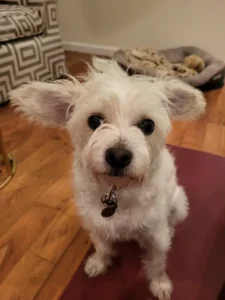Getting Your Dog Ready For Winter
As temperatures drop, getting your dog ready for winter becomes crucial to ensure they remain healthy and comfortable. Winter […]

Originally published in Bay Woof, October 2024
“Ask Dr. Dog”
Dr. Lisa Franzetta, L.Ac.
[email protected]

A friend reached out to me recently saying, “I think it’s time for Jack London to start seeing you.” Her nine-year-old supermutt had a history of intervertebral disc disease (IVDD), the most common spinal disease in dogs and a frequent cause of canine back pain. As an animal acupuncturist, a significant percentage of my furry patient base is dogs with IVDD, like little Jack London.
It turns out my friend must have received a psychic “Call of the Wild”–because just a couple of days before Jack London’s scheduled acupuncture treatment with me, he had an IVDD flare up, causing him enough pain that he was unable to bound out to his favorite haunts by Oakland’s Lake Merritt. Fortunately, holistic treatment for IVDD, including acupuncture and cold laser, can provide excellent support to dogs with this condition.
A dog’s spine is made up of bones called vertebrae, which protect the spinal cord that runs through them. Vertebrae have cartilaginous cushioning discs between them. When these discs degenerate and “dry out,” they become prone to herniation, which can cause pain and compression of the spinal cord. In serious cases, neurological injury and even paralysis can result.
It is estimated that IVDD affects 2% of the domestic dog population. Sometimes, this degeneration is age-related and happens gradually–typically in older, larger-breed dogs.
In another type of IVDD, a genetic mutation called “chondrodystrophy,” commonly occurring in dog breeds with short legs–like Dachshunds, Frenchies, and Corgis– causes a dog’s discs to degenerate prematurely, resulting in symptoms that appear earlier in a dog’s life. Seventy-five percent of chondrodystrophic dogs show some disc degeneration by just one-year-old.
Despite his punk rock appearance, Jack London’s doggie DNA test revealed that he is part poodle, another small breed prone to IVDD. His first flare up occurred at age three with an abrupt onset, which is typical for this type of IVDD.
For many dogs experiencing IVDD-related injury for which emergency surgery is not absolutely necessary, acupuncture can be one of the most effective treatment options. Studies have found that dogs treated with acupuncture along with “standard treatment” (such as steroids and pharmaceutical painkillers) recover more quickly from IVDD than dogs receiving standard treatment alone. Acupuncture has also been demonstrated to help dogs recover the ability to walk and recover sensation in the hind legs faster. In dogs who require emergency surgery to prevent permanent neurological damage, post-operative acupuncture can help speed their recovery.
In Chinese medicine-lingo, we understand IVDD as resulting from a “deficiency of Kidney Jing”–a way of describing this hereditary cartilage abnormality. The obstruction in the smooth flow of Blood (circulation) and Qi (energy) that results from disc degeneration and herniation cause the symptoms we often see in dogs suffering from IVDD, including pain, weakness, and lameness or paralysis. Acupuncture supports the Kidney energy and promotes the flow of Blood and Qi. In Western terminology, we can say that acupuncture stimulates nerves, muscles, and connective tissue, controls inflammation, and modulates neurotransmitters and pain stimulating pathways in the nervous systems.
Along with the ancient medicine of acupuncture, a very modern treatment–cold laser, a type of light therapy, or “photobiomodulation”–is another non-invasive treatment that can improve recovery in dogs experiencing the effects of IVDD. Laser therapy uses specific wavelengths of light to reduce inflammation, which improves neurological symptoms after damage to the spinal cord.
Jack London’s current treatment plan is in keeping with what I recommend for many canine patients experiencing low-grade IVDD (where there is pain but no neurological deficits)–once a week acupuncture and cold laser treatment for one to two months, to be followed by preventative, maintenance treatments as needed.
By promoting good circulation–”the flow of Qi and Blood”–regular maintenance acupuncture can help prevent traumatic recurrences in dogs who have already experienced IVDD-related disc herniations, including those who have had back surgery. As dogs age, IVDD can contribute to spinal stiffness and arthritis, another common cause of back pain, and acupuncture is also an effective way of managing arthritis pain.
For pet parents of Dachshunds, French Bulldogs, Corgis, Beagles, Shih Tzus, Basset Hounds, and other short-legged breeds or breed mixes who are prone to IVDD, I recommend preventative acupuncture care starting when they are young adults. Treatment approximately four times a year can be a good maintenance schedule for dogs who have not yet experienced any symptoms–with the goal of keeping your dog healthy, happy, and out of the emergency vet’s office.
Please note that abrupt onset of severe hind end pain, lack of sensation, limited mobility, or paralysis in your dog is an emergency situation requiring immediate assessment by a veterinarian. Discuss options for holistic support with your vet or animal acupuncturist.
This article was originally published in the October 2024 issue of Bay Woof.
Dr. Lisa is a doctor of acupuncture and integrative medicine, a licensed acupuncturist, and a fellow of the American Board of Animal Acupuncture. Questions about whether acupuncture can help your animals? Schedule a free 15-minute Chinese medicine consultation with Dr. Lisa by contacting Marina Village Veterinary.